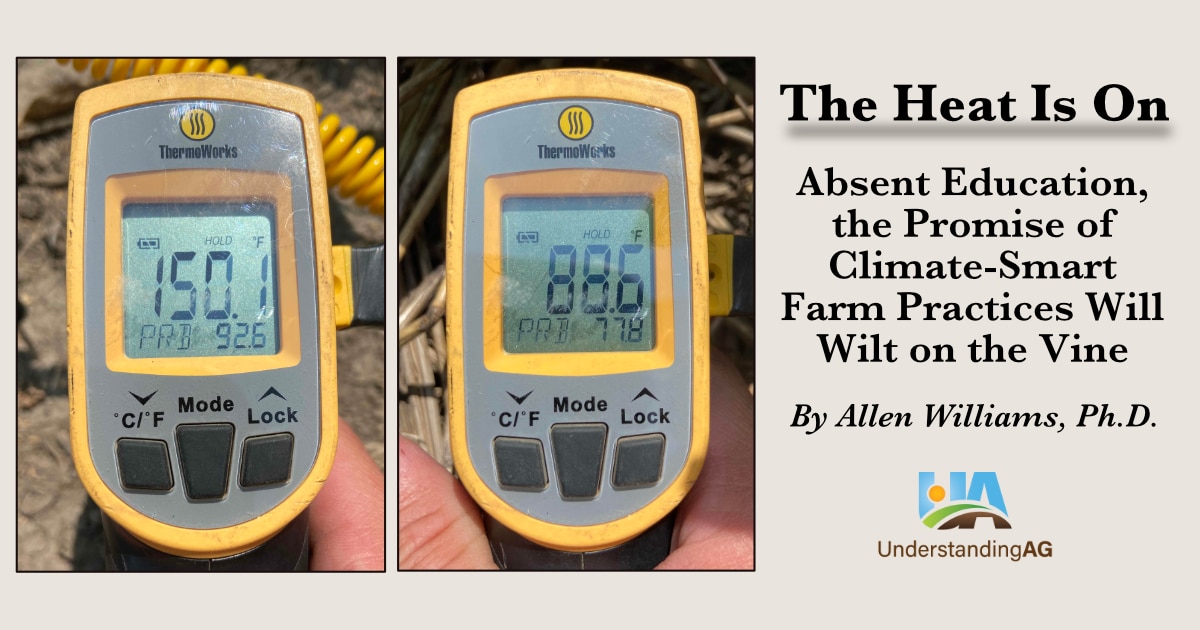
Without Education, the Promise of Climate-Smart Farm Practices Will Wilt on the Vine
By Allen Williams, Ph.D.
The digital screen displayed 162 F.
I pointed my infrared thermometer and squeezed the trigger again. No change. The readout showed 162 F, which just happens to be the safe food preparation temperature for ground beef and sausage.
But I wasn’t pointing the thermometer at my dinner. I was pointing it at a conventionally tilled, recently harvested wheat field near Gordon, Nebraska. Regrettably, I would discover that field wasn’t an anomaly.
During a weeks-long trip in August, I visited farms and ranches in Utah, Idaho, Wyoming, South Dakota and Nebraska. I consistently measured soil temperatures topping 150 degrees. With the ambient air temperature ranging from 97-102 F, I measured soil surface temperatures on a variety of fields, including mowed hay fields (alfalfa, grass) that had temperatures consistently above 150 degrees. Any temperature above 140 F essentially pasteurizes the soil microbiome and kills the essential soil microbes that play a critical role in the photosynthetic process—the process that enables all terrestrial life.
Anywhere the soil was even somewhat exposed to direct sunlight, soil temperatures were 150 F and above. But the high ambient air temperatures aren’t the only factors producing soil surface temperatures that can literally cook eggs.
Conventional farming practices, including our stubborn addiction to tillage, are increasingly creating micro-to-macro climates across large swaths of our heartland, further disrupting the normal water cycle of transpiration, evaporation, condensation and precipitation. Sadly, the fields I visited are representative of hundreds of thousands of fields and millions of cropland acres throughout the nation.
Facts can be stubborn things. So, too, can our habits. Despite what we see and experience on our own farms and ranches, the conventional farming mindset of tillage, fallow fields, and monocultures of corn and wheat have rendered our soils lifeless and less and less able to capture and retain water—and to be part of a functioning water cycle.
The conventional mindset persists in because of status quo bias, tradition and fear of the unknown. A key antidote to this mindset is education.
The recently enacted Inflation Reduction Act provides roughly $8.5 billion to pay for projects and practices that restore the ecosystem or reduce emissions on farmland through USDA’s Environmental Quality Incentives Program. The program provides funding for cover crop seeds and incentivizes farmers to implement other climate-friendly, regenerative practices.
Despite this good news, USDA’s emphasis on financial assistance, absent accompanying soil health education and training, will inevitably lead to wasted funding, farmer frustration and climate-smart practice failures. And once a farmer has a bad experience with a practice, there’s little chance he or she will ever try it again.
That’s why education is critical to the success of this important investment. And while government agencies are not well equipped to provide regenerative farming education to farmers and ranchers, there are proven non-government organizations that are already conducting farmer-to-farmer regenerative ag learning sessions. Programs like these need to be scaled up to reach many more farmers. Combined with on-line training options, these efforts can help ensure the successful implementation of soil health-focused, climate-smart, regenerative agricultural practices.
Finally, it’s also important that USDA examine the “not-so-climate-smart” elements in its existing farm programs. The so-called “safety net” of crop insurance programs, for example, continues to enable and perpetuate ag practices that are undeniably contributing to the climate crisis and reducing our food security—offsetting the overall positive impact of the climate-smart effort. Likewise, farm programs that subsidize monoculture commodity crops also provide financial disincentives for climate-smart practice adoption.
As it stands, the farm fields I referred to in my introduction will be tilled and planted again, using many of the same conventional practices and the same costly synthetic inputs that continue to degrade our soil resources and our collective futures—all thanks to taxpayer funded crop insurance and support programs.
For climate-smart farming to truly succeed, USDA must couple its climate-smart farming funding with education and eliminate the long-standing policies that continue to perpetuate and climate-damaging conventional agricultural practices. If it does not, the promise of a climate-smart future will quickly cool and the temperatures in our farm fields will rise well above 162 F.
